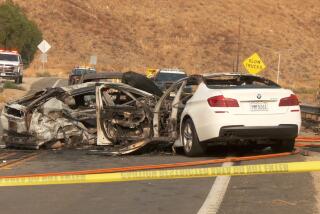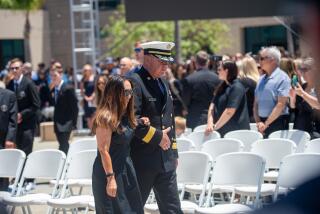Platform : ‘People Get Scared By Horns and Sirens’
Los Angeles Police Chief Willie L. Williams has promised a thorough investigation of how a police car answering a call rammed a pickup truck Monday night, killing three children riding in the back. The accident served as a sad reminder of the conflicts between urban emergency vehicles and private cars. JAMES BLAIR talked with public safety officials, driver educators and driving examiners about those conflicts and how they might be reduced.
ALAN SCHROEDER
Assistant commander, Bureau of Fire Suppression and Rescue,
Los Angeles Fire Department.
Our old policy was that emergency vehicles had the right of way--and that’s still true, the vehicle code hasn’t changed. We would approach an intersection on a red light and slow down, look both ways and then respond through the intersection. Prior to 1985, we had a lot of close calls and intersection accidents. We changed our rules so that for all stop signs and red lights we come to at least a brief stop, look both ways and then proceed. That cut our intersectional accidents by 50%.
If other drivers just did what they were supposed to do and pulled to the right, it would be fine. But people are on their way home or to work and they don’t want to yield. They don’t move. They get confused. They get scared by the horns and sirens. They do all sorts of crazy stuff. We have people that pass us on the right while we’re responding to an emergency--just zip right by us. I have driven down the street, with red lights and siren with a person in front of me who continued driving 25 miles per hour. It’s unbelievable.
There are technologies out there that you can put on fire trucks and police cars that, as they approach the intersection, changes the light from red to green for (the emergency vehicle). Although you could probably say it would save this city millions in liability costs in the long run and pay for itself, they just don’t have the money to do it.
*
BERNIE ABRAMS
Driving performance evaluator, 28-year veteran of the Department of Motor Vehicles, based in Glendale.
Personally, I would like to see the public push for universal driver training for everybody like they do in some foreign countries. Then we would get a better quality driver.
I have had to fail quite a few people because they did not respond immediately to a siren or even seeing flashing emergency lights. No reaction. They didn’t know. It’s scary. (Dealing with emergency vehicles is) not a specific part of the driving examination, but if we see that it isn’t happening when it’s supposed to happen, that’s an automatic DQ, a disqualification. I have failed several for that.
The current California driving examination is highly defensive. In fact, we now require a pre-check that includes (operating the) parking brake, emergency flasher units, windshield wipers and so on. You’d be surprised at how many people will miss, or almost fail. They don’t know the location of their equipment.
I’ve had a lot of people get mad at me. They’ve had licenses in a lot of places and they come here and they fail. The reaction is, “I’ve been driving for 30 years and now you’re telling me I don’t know how?”
It’s not the quantity. It’s the quality.
*
RHETT S. PRICE
Officer, California Highway Patrol, Southern Division
There was a time when motorcycle officers were taught if they were in a situation where they were going to crash, how to lay down their motorcycles and minimize injuries.
That has changed. What is taught now at our academy is how to avoid putting yourself in a situation where you will get into an accident. If you are aware of your surroundings, your speed, traffic around you and are able to ride in a mode that can anticipate sudden movements such as lane changes or possibly a driver going through an intersection on a red light, you can avoid the accident rather than get into what would be a “controlled accident.”
*
DORIS DILLARD
Driver training coordinator, Los Angeles Unified School District
The Los Angeles Unified School District provides a classroom driver education program in high school. About 4,000 students take the course per semester.
There’s specific reference to emergency vehicles in the lessons that deal with urban driving. But the district is unable to offer the driver training laboratory, which is behind-the-wheel training, due to lack of funding at the state level. Funding previously came from the state penalty assessment fund--that’s traffic citations. But it has not been provided in recent years.
We’re very concerned because students need to have practical application of what they’ve learned in the classroom--about safety, not only of the young drivers, but other drivers, vehicles, pedestrians and cyclists they might come in contact with.
More to Read
Sign up for Essential California
The most important California stories and recommendations in your inbox every morning.
You may occasionally receive promotional content from the Los Angeles Times.










